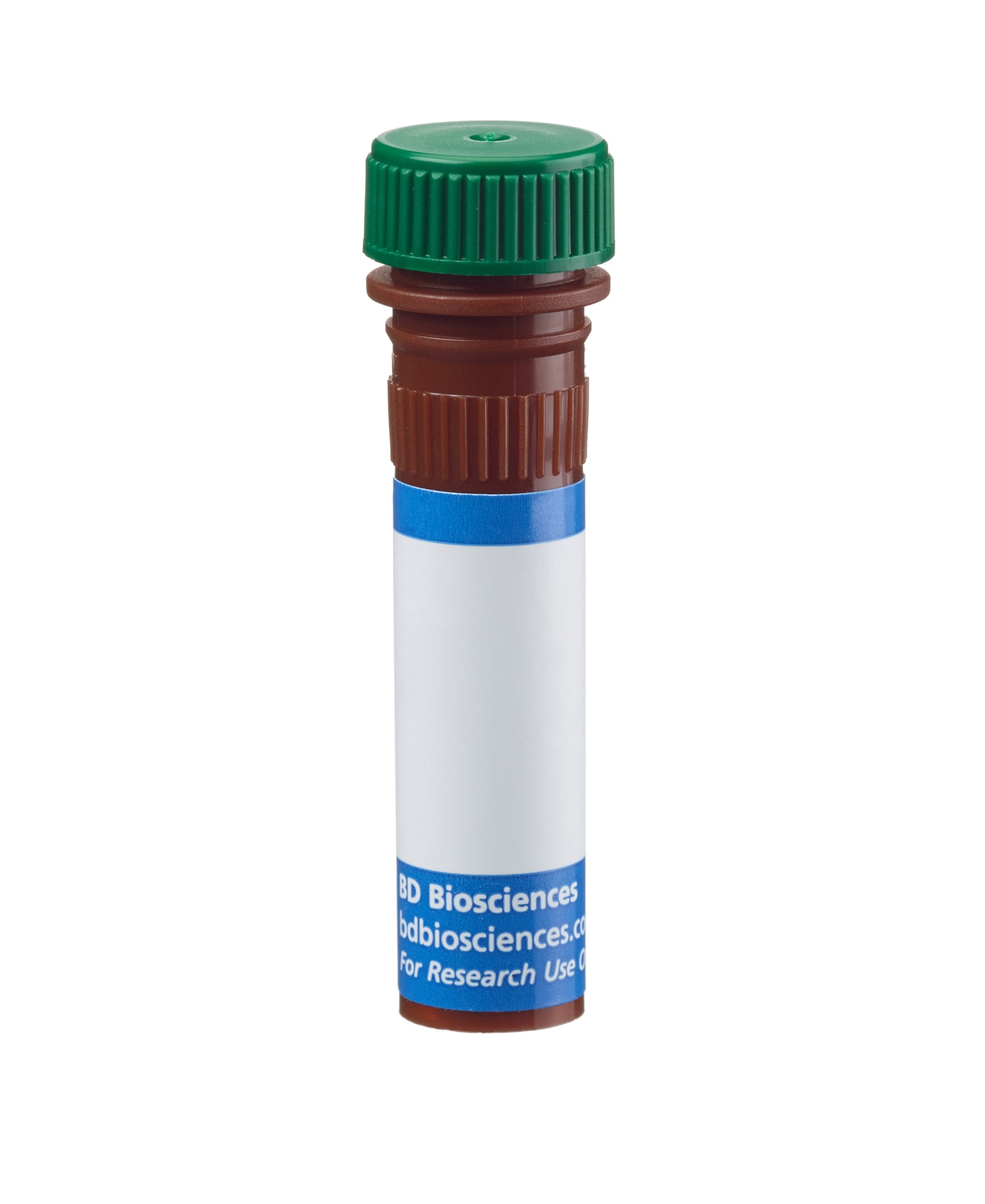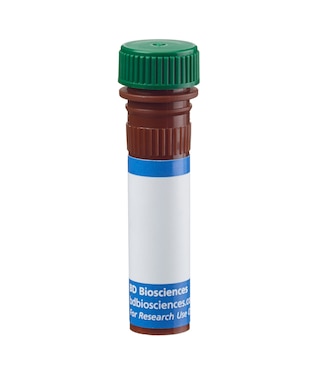Old Browser
Looks like you're visiting us from {countryName}.
Would you like to stay on the current country site or be switched to your country?




Two-color flow cytometric analysis of CD93 (Early B Lineage) expression on mouse bone marrow cells - Staining comparisons between BD Horizon™ BB515- and FITC-conjugated antibodies. Mouse bone marrow cells were preincubated with Purified Rat Anti-Mouse CD16/CD32 antibody (Mouse BD Fc Block™) (Cat. No. 553141/553142). The cells were then stained with APC Rat Anti-Mouse CD45R/B220 antibody (Cat. No. 553092/561880) and either BD Horizon™ BB515 Rat IgG2b, κ Isotype Control (Cat. No. 564421; Left Panel), BD Horizon BB515 Rat Anti-Mouse CD93 (Early B Lineage) antibody (Cat. No. 564700; Middle Panel), or FITC Rat Anti-Mouse CD93 (Early B Lineage) antibody (Cat. No. 559156/561990; Right Panel). Two-color flow cytometric contour plots showing the correlated expression of CD93 (Early B Lineage) [or Ig Isotype control staining] versus CD45R/B220 were derived from gated events with the forward and side-light scattering characteristics of viable bone marrow cells. Flow cytometric analysis was performed using a BD™ LSR II Flow Cytometer System.


BD Horizon™ BB515 Rat Anti-Mouse CD93 (Early B Lineage)

Regulatory Status Legend
Any use of products other than the permitted use without the express written authorization of Becton, Dickinson and Company is strictly prohibited.
Preparation And Storage
Recommended Assay Procedures
BD™ CompBeads can be used as surrogates to assess fluorescence spillover (Compensation). When fluorochrome conjugated antibodies are bound to CompBeads, they have spectral properties very similar to cells. However, for some fluorochromes there can be small differences in spectral emissions compared to cells, resulting in spillover values that differ when compared to biological controls. It is strongly recommended that when using a reagent for the first time, users compare the spillover on cells and CompBead to ensure that BD Comp beads are appropriate for your specific cellular application.
For optimal and reproducible results, BD Horizon Brilliant Stain Buffer should be used anytime two or more BD Horizon Brilliant dyes are used in the same experiment. Fluorescent dye interactions may cause staining artifacts which may affect data interpretation. The BD Horizon Brilliant Stain Buffer was designed to minimize these interactions. More information can be found in the Technical Data Sheet of the BD Horizon Brilliant Stain Buffer (Cat. No. 563794/566349) or the BD Horizon Brilliant Stain Buffer Plus (Cat. No. 566385).
For optimal results, it is recommended to perform 2 washes after staining with antibodies. Cells may be prepared, stained with antibodies and washed twice with wash buffer per established protocols for immunofluorescence staining, prior to acquisition on a flow cytometer. Performing fewer than the recommended wash steps may lead to increased spread of the negative population.
Product Notices
- Since applications vary, each investigator should titrate the reagent to obtain optimal results.
- An isotype control should be used at the same concentration as the antibody of interest.
- Caution: Sodium azide yields highly toxic hydrazoic acid under acidic conditions. Dilute azide compounds in running water before discarding to avoid accumulation of potentially explosive deposits in plumbing.
- For fluorochrome spectra and suitable instrument settings, please refer to our Multicolor Flow Cytometry web page at www.bdbiosciences.com/colors.
- Please refer to http://regdocs.bd.com to access safety data sheets (SDS).
- BD Horizon Brilliant Stain Buffer is covered by one or more of the following US patents: 8,110,673; 8,158,444; 8,575,303; 8,354,239.
- Please refer to www.bdbiosciences.com/us/s/resources for technical protocols.
Companion Products






The AA4.1 monoclonal antibody specifically recognizes the Early B Lineage antigen which is also known as CD93, AA4 antigen, Ly-68, and Complement component C1q receptor (C1qRp). This 130-140-kDa type I transmembrane glycoprotein is expressed on immature B lymphocytes in the adult bone marrow and on hematopoietic progenitors and stem cells in adult bone marrow, fetal liver, and embryonic yolk sac. Although CD93+ cells are most plentiful in adult mouse bone marrow, a smaller number of CD93+ cells which express lower CD93 levels can be detected in the adult spleen using bright fluorescent conjugates of the AA4.1 antibody or an amplified indirect immunofluorescent staining procedure. It has been observed that the staining pattern of the 493 monoclonal antibody is similar to that of the AA4.1 antibody, in that both antibodies precipitate molecules of the same molecular weight. Staining with the AA4.1 antibody is not blocked by the 493 antibody. These results suggest that the antibodies recognize separate epitopes on the same Early B Lineage antigen.
The antibody was conjugated to BD Horizon BB515 which is part of the BD Horizon Brilliant™ Blue family of dyes. With an Ex Max near 490 nm and an Em Max near 515 nm, BD Horizon BB515 can be excited by the blue laser (488 nm) laser and detected with a 530/30 nm filter. This dye has been exclusively developed by BD Biosciences and is up to seven times brighter than FITC with less spillover into the PE channel. Due to similar excitation and emission properties, BB515, FITC, and Alexa Fluor® 488 cannot be used simultaneously. It is not recommended to use BB515 in cocktails that include Streptavidin conjugates as it may cause high background.

Development References (9)
-
Allman D, Li J, Hardy RR. Commitment to the B lymphoid lineage occurs before DH-JH recombination. J Exp Med. 1999; 189(4):735-740. (Clone-specific: Flow cytometry, Fluorescence activated cell sorting). View Reference
-
Allman D, Lindsley RC, DeMuth W, Rudd K, Shinton SA, Hardy RR. Resolution of three nonproliferative immature splenic B cell subsets reveals multiple selection points during peripheral B cell maturation. J Immunol. 2001; 167(12):6834-6840. (Clone-specific: Flow cytometry, Fluorescence activated cell sorting). View Reference
-
Auerbach R, Huang H, Lu L. Hematopoietic stem cells in the mouse embryonic yolk sac. Stem Cells. 1996; 14(3):269-280. (Clone-specific). View Reference
-
Jordan CT, McKearn JP, Lemischka IR. Cellular and developmental properties of fetal hematopoietic stem cells. Cell. 1990; 61(6):953-963. (Clone-specific: Flow cytometry). View Reference
-
Lacaud G, Carlsson L, Keller G. Identification of a fetal hematopoietic precursor with B cell, T cell, and macrophage potential. Immunity. 1998; 9(6):827-838. (Clone-specific). View Reference
-
Li YS, Wasserman R, Hayakawa K, Hardy RR. Identification of the earliest B lineage stage in mouse bone marrow. Immunity. 1996; 5(6):527-535. (Clone-specific: Flow cytometry, Fluorescence activated cell sorting). View Reference
-
McKearn JP, Baum C, Davie JM. Cell surface antigens expressed by subsets of pre-B cells and B cells. J Immunol. 1984; 132(1):332-339. (Immunogen: Cell separation, Depletion, Flow cytometry). View Reference
-
Paige CJ, Gisler RH, McKearn JP, Iscove NN. Differentiation of murine B cell precursors in agar culture. Frequency, surface marker analysis and requirements for growth of clonable pre-B cells. Eur J Immunol. 1984; 14(11):979-987. (Clone-specific). View Reference
-
Szilvassy SJ, Cory S. Phenotypic and functional characterization of competitive long-term repopulating hematopoietic stem cells enriched from 5-fluorouracil-treated murine marrow. Blood. 1993; 81(9):2310-2320. (Clone-specific: Flow cytometry, Fluorescence activated cell sorting). View Reference
Please refer to Support Documents for Quality Certificates
Global - Refer to manufacturer's instructions for use and related User Manuals and Technical data sheets before using this products as described
Comparisons, where applicable, are made against older BD Technology, manual methods or are general performance claims. Comparisons are not made against non-BD technologies, unless otherwise noted.
For Research Use Only. Not for use in diagnostic or therapeutic procedures.
Report a Site Issue
This form is intended to help us improve our website experience. For other support, please visit our Contact Us page.